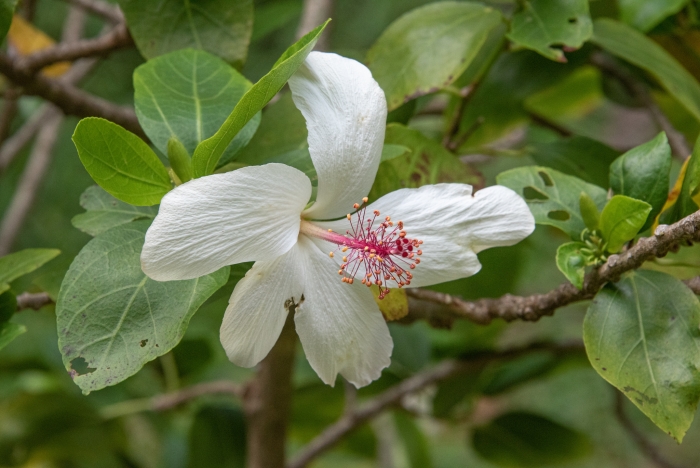White Kauai Rosemallow
(Hibiscus waimeae)
White Kauai Rosemallow (Hibiscus waimeae)
/
/

Don Loarie
CC BY 4.0
Image By:
Don Loarie
Recorded By:
Copyright:
CC BY 4.0
Copyright Notice:
Photo by: Don Loarie | License Type: CC BY 4.0 | License URL: http://creativecommons.org/licenses/by/4.0/ | Rights Holder: Don Loarie | Publisher: iNaturalist | Date Created: 2022-05-22T10:15:47-07:00 |




























Estimated Native Range
Summary
Hibiscus waimeae, commonly known as white Kauai rosemallow, is a small deciduous tree endemic to the island of Kauaʻi in Hawaii. It is found in mesic and wet forests at elevations ranging from 820 to 3937 feet. This species is notable for its smooth gray bark and its large, showy white flowers that bloom year-round and fade to pink within a day, emitting a pleasant fragrance. The flowers are particularly attractive to native pollinators. Hibiscus waimeae typically reaches a height of 20-33 feet with a moderate growth rate.
The white Kauai rosemallow is valued for its fragrant, ornamental flowers, which are used in leis and traditional Hawaiian decorations. It thrives in well-draining, fertile soils and requires regular watering, especially during dry periods. While it prefers full sun to part shade, it can tolerate a range of light conditions. The plant is relatively low-maintenance but can be susceptible to pests such as aphids and whiteflies. The endangered subspecies H. waimeae subsp. hannerae, which grows in the northwestern valleys of Kauaʻi, is recognized for its cultural significance and has been used by Native Hawaiians for both decorative and medicinal purposes. Gardeners should be aware that while the plant is not typically invasive, it is best suited to tropical and subtropical climates and may struggle in colder regions.CC BY-SA 4.0
The white Kauai rosemallow is valued for its fragrant, ornamental flowers, which are used in leis and traditional Hawaiian decorations. It thrives in well-draining, fertile soils and requires regular watering, especially during dry periods. While it prefers full sun to part shade, it can tolerate a range of light conditions. The plant is relatively low-maintenance but can be susceptible to pests such as aphids and whiteflies. The endangered subspecies H. waimeae subsp. hannerae, which grows in the northwestern valleys of Kauaʻi, is recognized for its cultural significance and has been used by Native Hawaiians for both decorative and medicinal purposes. Gardeners should be aware that while the plant is not typically invasive, it is best suited to tropical and subtropical climates and may struggle in colder regions.CC BY-SA 4.0
Plant Description
- Plant Type: Shrub, Tree
- Height: 10-30 feet
- Width: 8-15 feet
- Growth Rate: Moderate
- Flower Color: White
- Flowering Season: Spring, Summer
- Leaf Retention: Deciduous
Growth Requirements
- Sun: Full Sun, Part Shade
- Water: Medium
- Drainage: Medium
Common Uses
Bird Garden, Butterfly Garden, Fragrant, Low Maintenance, Potted Plant, Showy Flowers
Natural Habitat
Mesic and wet forests at elevations of 820 to 3937 feet on the island of Kauaʻi in Hawaii
Other Names
Common Names: Koki’o ke’oke’o, Hawaiian White Hibiscus, Waimea Hibiscus
Scientific Names: , Hibiscus waimeae, Hibiscus waimeae var. hannerii,
GBIF Accepted Name: